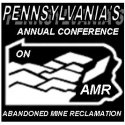Video by Michael Hewitt
Article By Paul Golias, Correspondent
The massive water pools under the Wyoming Valley are both a potential blessing and a curse.
The topmost level of the stratified 274.3 billion gallons of water is useable for industrial and commercial applications. The water could be purified for drinking if a drought emergency required such actions. That is the blessing.
The curse is the potential for subsidence is the pool is so dramatically disturbed that the ebb and flow of water causes surface problems ranging from flooding to serious subsidence that damages homes and businesses. Additionally, tapping the topmost strata of water would leave polluted water for potential future uses.
“Is there a danger? Yes.” said Robert Hughes, Executive Director of EPCAMR. “We need to focus on quality and stratification,” he said.
We know more about the water pool today than any period in the history of heavily-mined Wyoming Valley due to the extensive pool mapping work of EPCAMR. Hughes said EPCAMR used surface mine maps, underground mine maps, and cross section maps withing municipal boundaries obtained from the now-closed Federal Office of Surface Mining Folio Maps. The maps had been housed in the Stegmaier Building, Wilkes-Barre.
In addition, EPCAMR staff has monitored mine pool levels through boreholes around the Wyoming Valley. Unfortunately, some of those boreholes are being paved over.
Michael Hewitt, EPCAMR Program Manager, said a borehole in the Hanover Industrial Park was recently paved over during construction of new roads in connection with a major warehouse project there.
The borehole, Hewitt said, was near a sewer cover on the shoulder of the road. He could easily take readings of the Huber Colliery pool in that borehole, he said.
“We are down to 22 boreholes in the Wyoming Valley,” Hewitt said. The 15 that have been lost include three paved over in Exeter Borough and three more in Plymouth Borough, Hewitt said.
Hughes said it is vital to focus on the importance of the water pools due to the interest by natural gas producers in using mine water for fracking, the process that uses water under pressure to fracture the underground shale deposits that hold natural gas.
At the same time, plans for the PennEast Pipeline are unclear and EPCAMR has warned that a pipeline placed in the alluvial material atop the mine water pools could impact the pools, depending on the depth of the pipeline. Also, barrier pillars that separate the pools are in play, Hughes said.
The alluvial material, mainly sand and gavel, has been dubbed The Buried Valley of the Susquehanna. The alluvium is at various thicknesses under the Susquehanna, such as 142 feet at the levee in Wyoming. There are many veins of coal mapped under the Susquehanna and the entire valley, Hughes said. The withdrawal of water and the disturbance of the pools poses “a risk for mine subsidence,” he said.
Hughes recommended that people who do not have mine subsidence insurance consider obtaining a policy. He estimated only 10 percent of Wyoming Valley homeowners have such insurance.
Meanwhile, EPCAMR is providing municipalities in the former anthracite mining area with free mining maps to assist in community planning, coping with possible natural gas pipeline placement, and with mine subsidence issues.
Ironically, a $5,000 grant to the agency from PennEast Pipeline’s Community Connector Grant Program made the project possible. PennEast said it links with not-for-profit organizations to support safety, environment and education, and energy sector workforce development.
Hughes said the top 20 feet of water in the pools is “relatively clean.” The next 30-40 feet gets murkier and sediment increases at lower depths until the bottom of the pool where the water is “blackest of black,” he said.
Some mine water flows into streams and acid mine drainage projects have been underway for years. EPCAMR has been involved in those as has Earth Conservancy, where EPCAMR has its offices.
The water can flow back and forth between pools, across barriers left in place by mining companies as boundary lines. Some barriers were removed when one company bought another, Hughes said.
Using historical data and current water measurements, EPCAMR arrived at the staggering 274.3 billion gallons estimate for the mine pools under the valley. That does not include the Butler Mine Pool for which data is lacking.
Mine water is being used for geothermal energy development and industrial processes. The ARIPPA co-generaltion plant in Schuylkill County uses mine water to cool a tower. Frackville Wheelabrator uses mine water to runa stream generator that heats and cools the state correctional facility at Frackville.
Earlier this month, Kenneth M. Klemow, professor of biology and environmental sciences at Wilkes Unviersity, and colleagues released a report on the potential impact of natural gas drilling on surface water, such as streams, creeks, and rivers. The predictive model did not prove drilling impacts on streams but it did project vulnerability.
Hughes said much more work needs to be done to study the mine pools, including how they impact surface water. He said a regional approach is necessary, an approach taken in a landmark 1949 report on underground water in area mines by Steven Ash and others of the Bureau of Mine, U.S. Department of the Interior. EPCAMR used Ash’s data in its calculations.
Hughes is on Pennsylvania’s Department of Environmental Protection’s Pipeline Infratructure Task Force’s Environmental Protection Workgroup to address pipeline infrastructure and development concerns related to abandoned mines.











